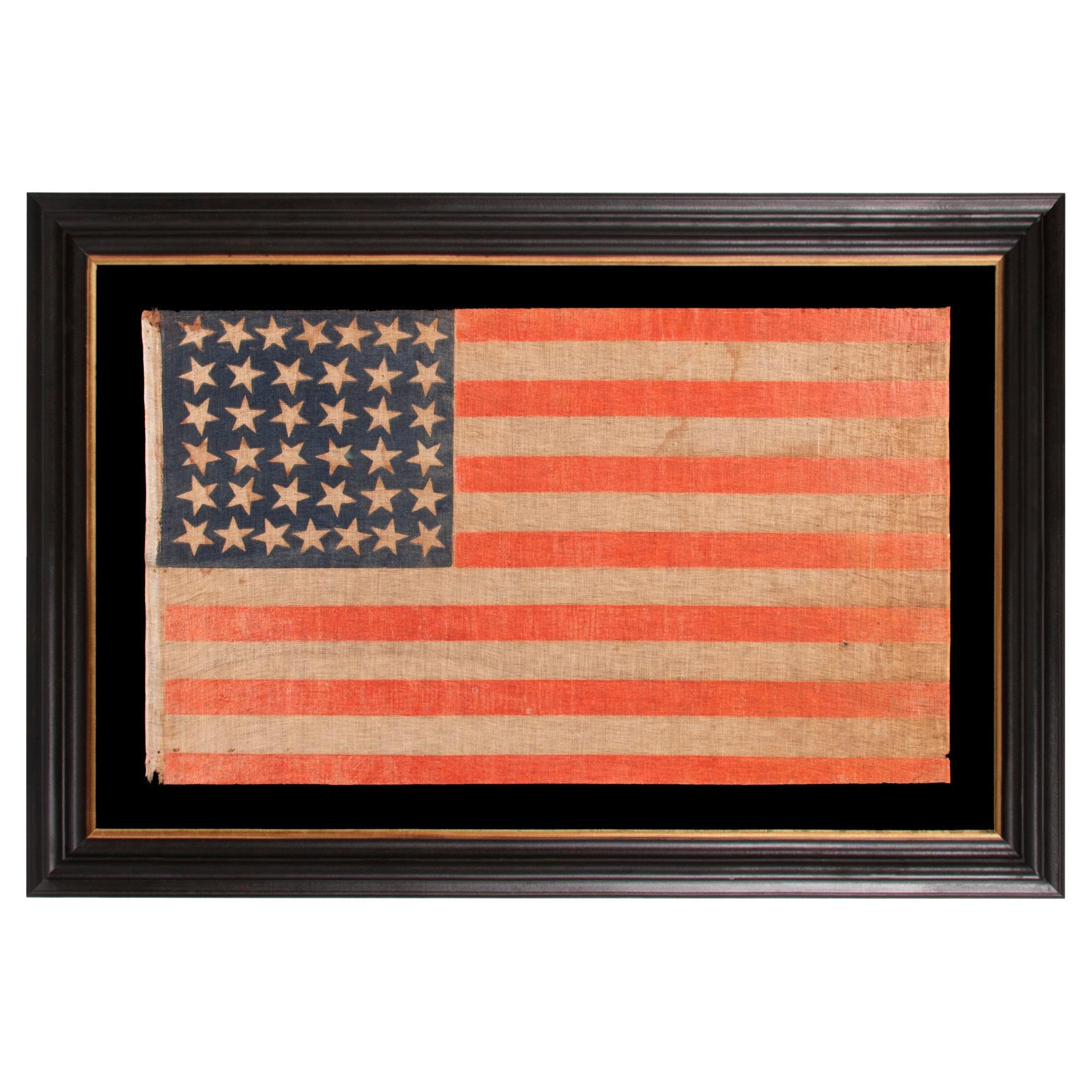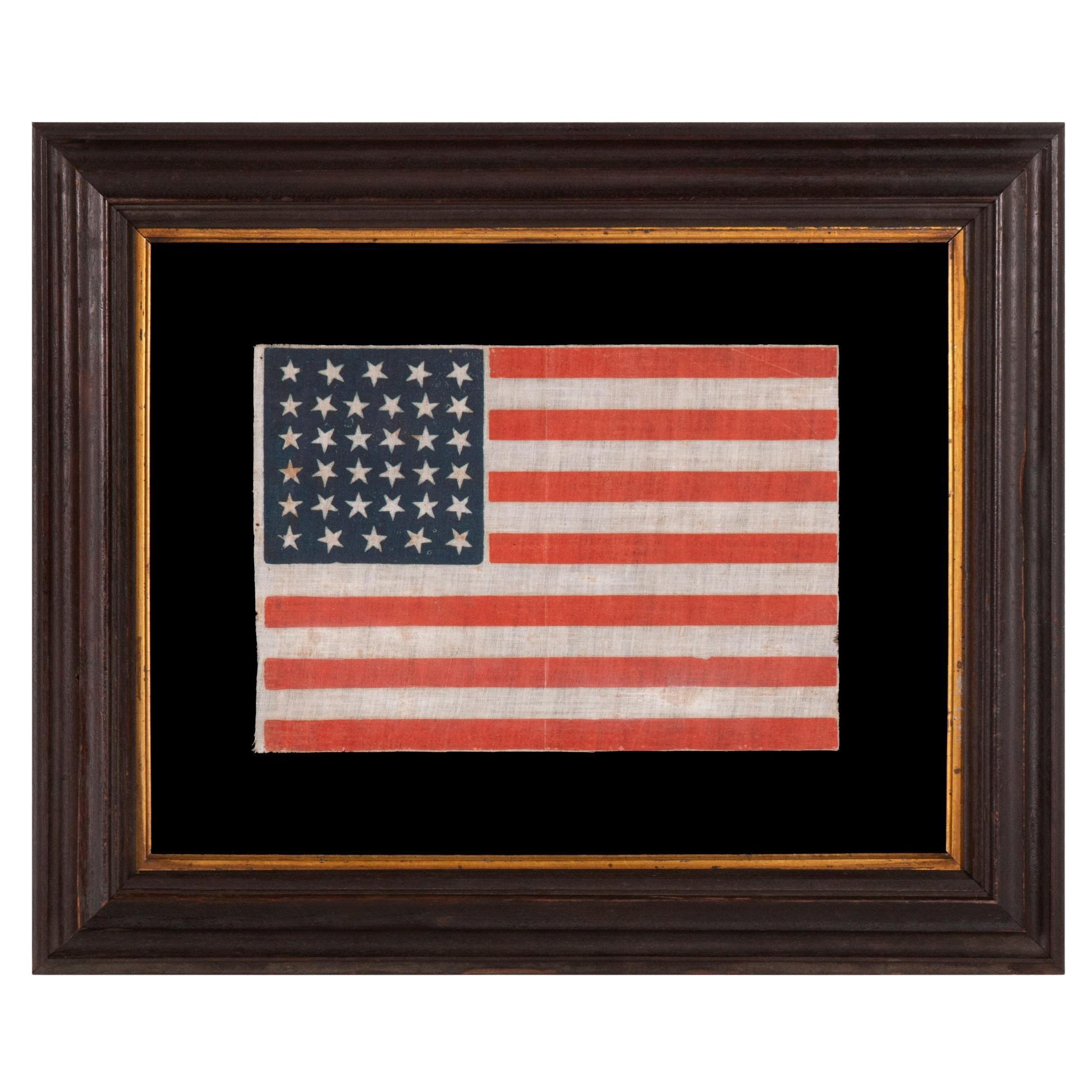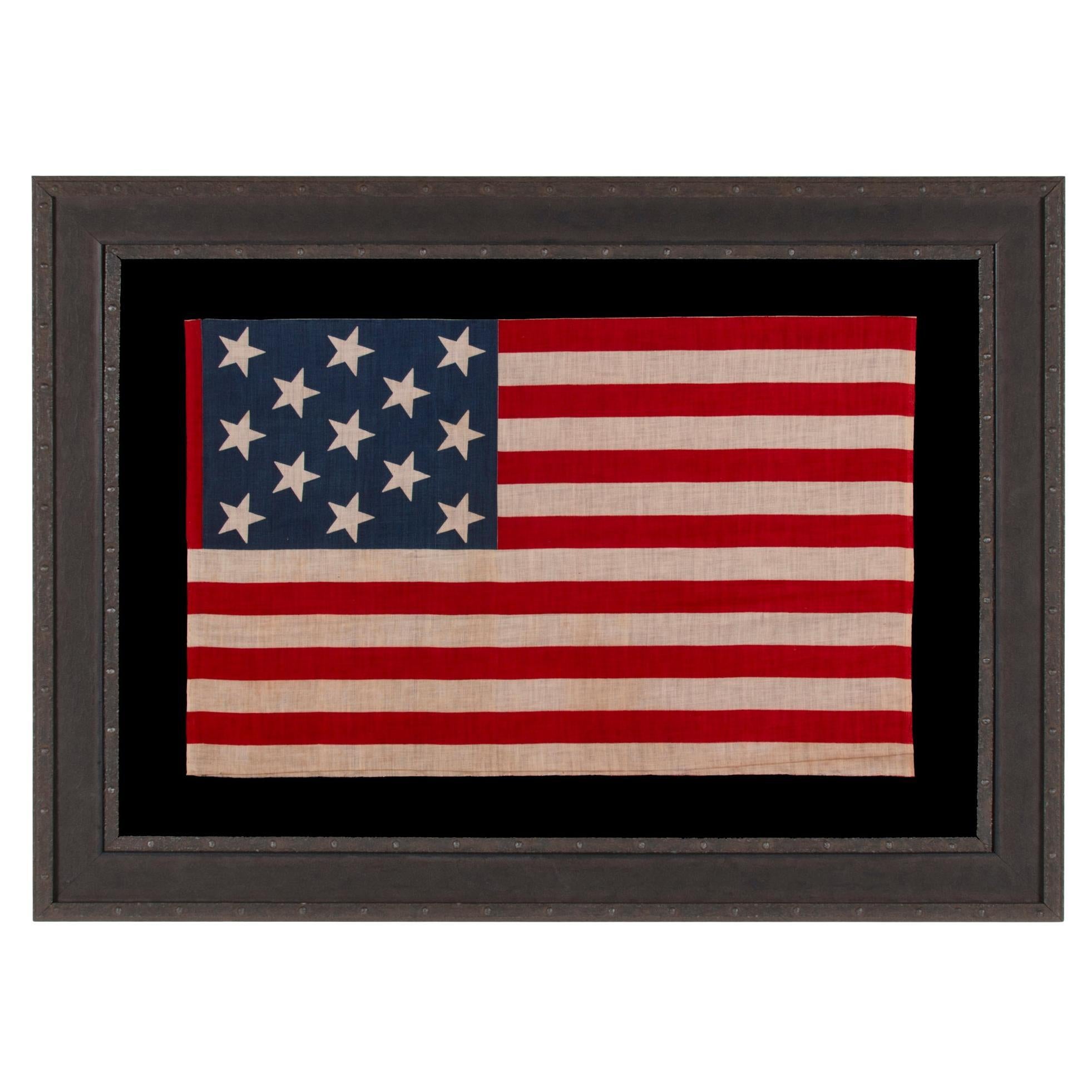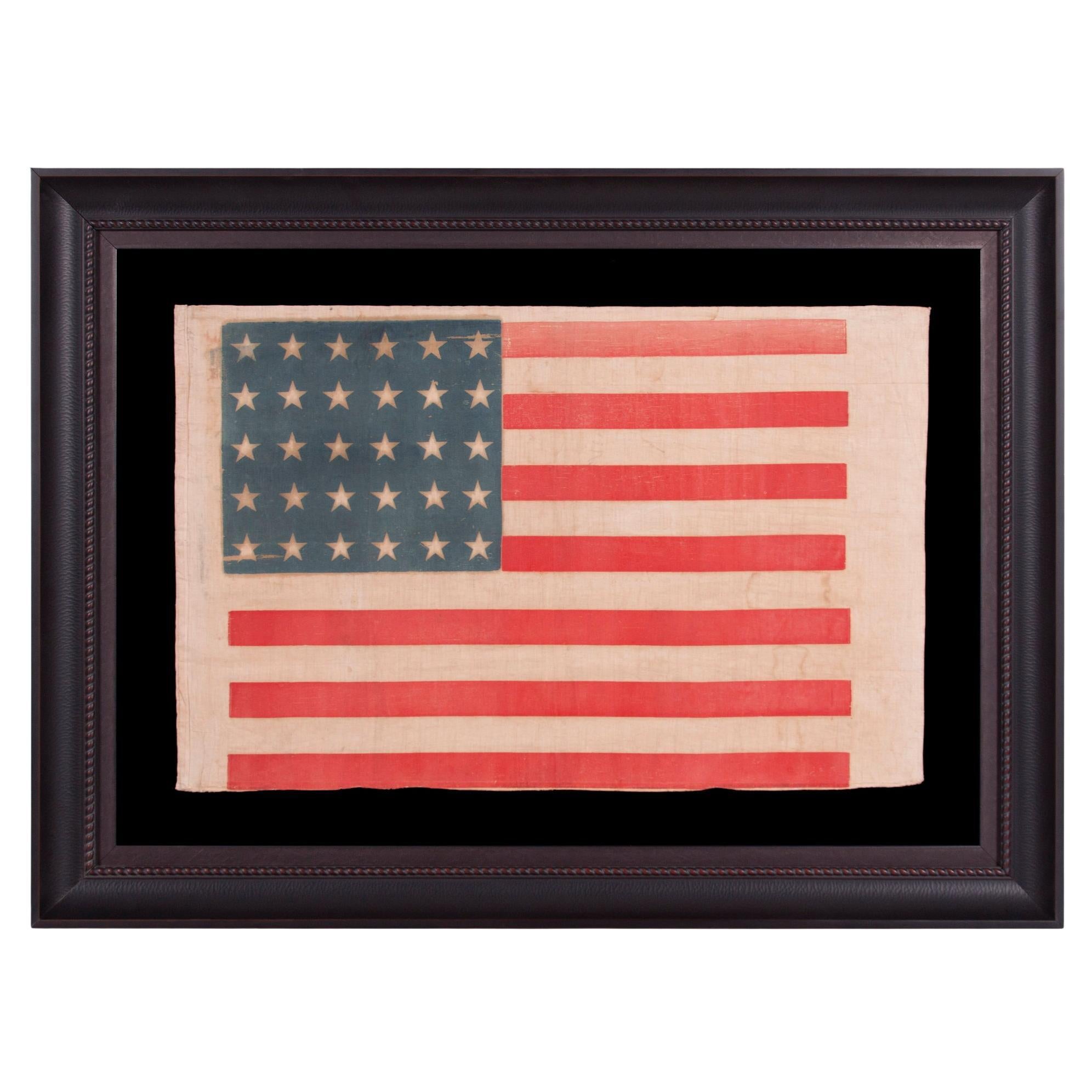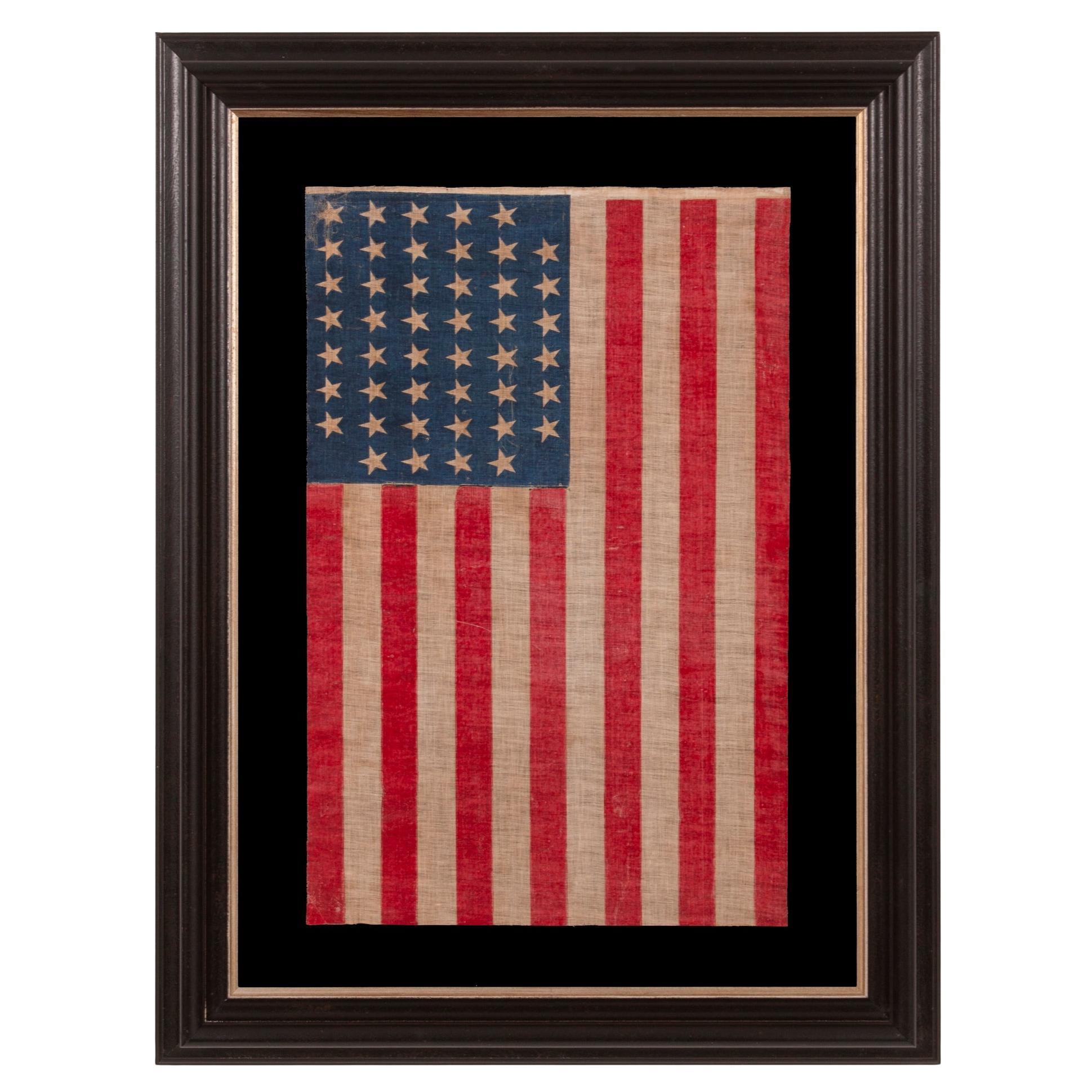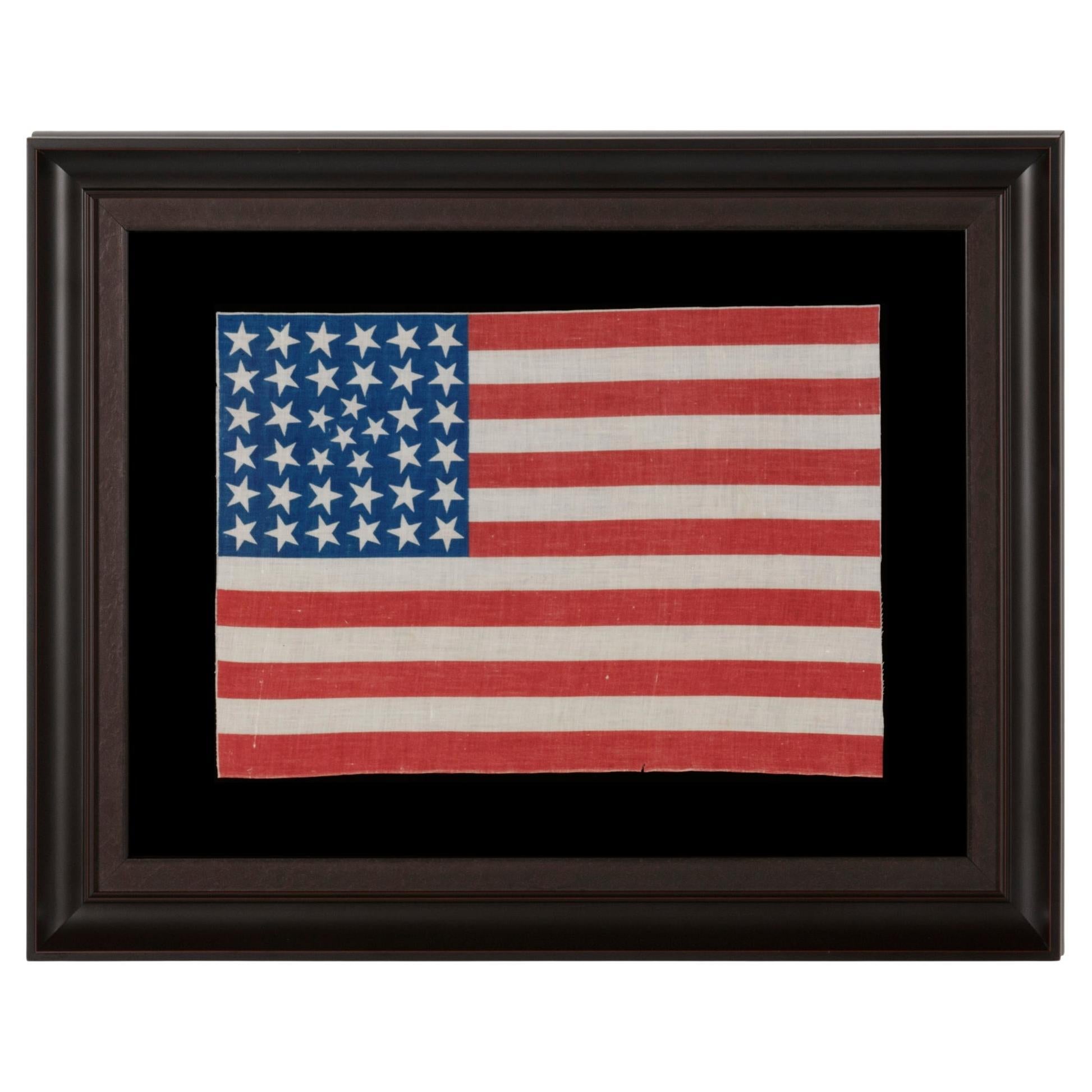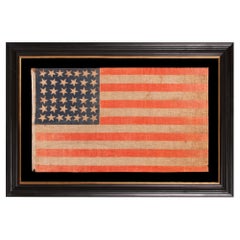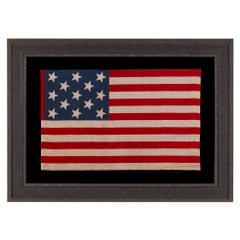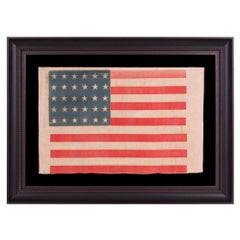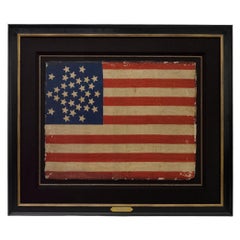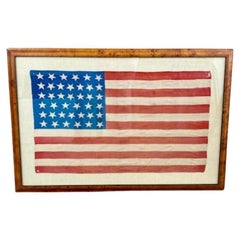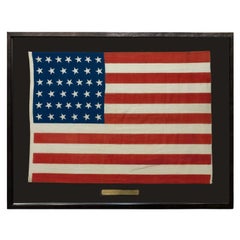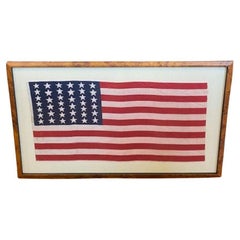Items Similar to 33 Star Antique American Parade Flag, Oregon Statehood, ca 1859-1861
Want more images or videos?
Request additional images or videos from the seller
1 of 5
33 Star Antique American Parade Flag, Oregon Statehood, ca 1859-1861
$1
£0.77
€0.89
CA$1.41
A$1.58
CHF 0.83
MX$19.21
NOK 10.51
SEK 9.97
DKK 6.66
About the Item
33 STARS IN A MEDALLION CONFIGURATION ON A LARGE SCALE ANTIQUE AMERICAN PARADE FLAG, AN EXTREMELY RARE EXAMPLE, OREGON STATEHOOD, 1859-1861
This 33 star American parade flag, printed on coarse, glazed cotton, is an especially large and visually attractive example and is one of perhaps just ten - twelve known to exist in this rare style. The design consists of a cross of 5 stars in the center, surrounded by 2 consecutive wreaths, with 2 flanking stars outside the primary pattern, placed toward the fly end. Typically there are 4 flanking stars in this type of medallion arrangement, placed one in each corner of the blue canton. The inclusion of only two was intentional, leaving room for the easy addition of two more states. Flag-makers knew that more Western Territories would soon follow and eagerly anticipated their arrival.
Note that the star in the very center of the configuration is actually a hair smaller than the rest. This may have not been precisely intentional, but it is an interesting peculiarity and may indicate that the original print block was made with 32 stars, carved in relief, and that an additional one was caved in the center when Oregon gained statehood. If this were so, the corresponding 32 star examples remain unknown, so far as I am aware.
The size of the flag is especially large among parade flags, which are typically 3 feet long or smaller. Piece-and-sewn flags of this era, by contrast, are generally 8 feet long and larger. Because flags measuring greater than 3 feet and less than 6 feet are more unusual than their counterparts, especially among those that display dynamically visual star patterns, and because this general scale is extremely desirable for the purposes of being conserved and framed for display, flags that meet these criteria are especially desirable among both serious collectors and one-time buyers alike.
The flag that is the subject of this narrative was found with a small group of like kind. Before their discovery, only three others were known in this exact style. One was formerly part of the collection of Boleslaw and Marie D’Ostrange-Mastai, who held one of the most important private collections of American flags in the country and whose book, "The Stars and the Stripes" (knopf, New York, 1973), was the first major reference on the subject of flag collecting. The Mastai example was not pictured in their text, but was a part of their substantial, undocumented holdings.
Oregon entered the Union as the 33rd state on February 14th (Valentines Day), 1859. Following the adoption of the Third Flag Act, in 1818, stars were officially added on Independence Day for any new state that entered over the previous “flag year.” Because the makers of flags both public and private cared little for official star counts, preferring instead what was practical, the 33rd star would have been added by most upon its admission to statehood. Because the 33 star flag remained official from 1859-1861, and was thus still the official flag when Ft. Sumter was fired upon, on April 12th of that year—an event that marked the beginning of the Civil War—a 33 star flag happened to be flying at Ft. Sumter during the attack. However, because Kansas entered the Union as the 34th state approx. 2.5 months prior, on January 29th, 1861, wartime production jumped straight to the 34 star count, soon to become official on July 4th. For this reason 33 star flags were not generally produced for the war, which would last until 1865, and were generally made pre-war. It is for this reason that 33 star examples are far-and-away more scarce than their 34, 35, and 36-star counterparts.
Flags made prior to the Civil War are extremely rare, comprising around one percent of 19th century flags that exist in the 21st century. Prior to the Confederate attack on Fort Sumter in 1861, the Stars & Stripes was simply not used for most of the same purposes we employ it in today. Private individuals did not typically display the flag in their yards and on their porches. Parade flags didn't often fly from carriages and horses. Places of business rarely hung flags in their windows. The only consistent private use prior to 1861 seems to have accompanied political campaigning.
Even the military did not use the national flag in a manner that most people might think. Most people are surprised to learn that the infantry wasn't authorized to carry the Stars & Stripes until well into the 19th century. The foremost purpose before the Civil War (1861-65) was to identify ships on the open seas. While the flag was used to mark garrisons and government buildings, the flags of ground forces were limited to the those of their own regiment and a perhaps a federal standard (a blue or buff yellow flag bearing the arms of the United States). Artillery units were the first to be afforded the privilege to carry the national flag in 1834. Infantry followed in 1841, but cavalry not until 1862. The first actual war in which the Stars & Stripes was officially carried was thus the Mexican War (1846-48). In more than 20 years of aggressive buying and research, I have encountered almost no American national flags produced in an obvious military style that are of the Mexican War period. They exist, but are extraordinarily rare, even among museum holdings.
Note how the strong shades of indigo blue and sunfire red create a striking contrast that is especially attractive on this particular 33 star example. When combined with the large scale, a pre-civil war star count, the extreme rarity of this variety, and the bold and interesting star pattern, the result is a flag worthy of any major collection.
Mounting: For 25 years we have maintained a specialized department for this purpose. Our lead conservator holds a master's degree in textile conservation from one of the nation’s top university programs. We take great care in the mounting and preservation of flags and related textiles and have preserved thousands of examples.
The background is 100% cotton twill, black in color, that has been washed and treated for colorfastness. The black-painted and hand-gilded molding is Italian. The glazing is U.V. protective acrylic.
Condition: There is modest to moderate breakdown in the white stripes, below the canton, at adjacent to the hoist end, with some associated losses. Fabric of similar coloration was placed behind these areas during the mounting process. There are minor tears and losses in the white area along the hoist end, adjacent to the canton, where the flag was affixed to its original wooden staff. There is some shrinkage in the white stripes along the fly end. There are some lateral splits between the stripes. There is modest foxing and staining, predominantly visible in the white stripes in limited areas. Many of my clients prefer early flags to show their age and history of use.
- Dimensions:Height: 53.5 in (135.89 cm)Width: 38 in (96.52 cm)Depth: 2.5 in (6.35 cm)
- Materials and Techniques:
- Place of Origin:
- Period:
- Date of Manufacture:1859-1861
- Condition:See Item Description.
- Seller Location:York County, PA
- Reference Number:Seller: 33j-8641stDibs: LU849745827722
About the Seller
5.0
Recognized Seller
These prestigious sellers are industry leaders and represent the highest echelon for item quality and design.
Established in 1991
1stDibs seller since 2008
70 sales on 1stDibs
Typical response time: 1 to 2 days
- ShippingRetrieving quote...Shipping from: York County, PA
- Return Policy
Authenticity Guarantee
In the unlikely event there’s an issue with an item’s authenticity, contact us within 1 year for a full refund. DetailsMoney-Back Guarantee
If your item is not as described, is damaged in transit, or does not arrive, contact us within 7 days for a full refund. Details24-Hour Cancellation
You have a 24-hour grace period in which to reconsider your purchase, with no questions asked.Vetted Professional Sellers
Our world-class sellers must adhere to strict standards for service and quality, maintaining the integrity of our listings.Price-Match Guarantee
If you find that a seller listed the same item for a lower price elsewhere, we’ll match it.Trusted Global Delivery
Our best-in-class carrier network provides specialized shipping options worldwide, including custom delivery.More From This Seller
View All38 Star Antique American Parade Flag, Colorado Statehood, ca 1876-1889
Located in York County, PA
38 STAR ANTIQUE AMERICAN PARADE FLAG WITH JUSTIFIED ROWS OF 7-6-6-6-6-7 AND SCATTERED STAR ORIENTATION, MADE DURING THE PERIOD WHEN COLORADO WAS THE MOST RECENT STATE TO JOIN THE UNION, 1876-1889
38 star American national parade flag, printed on coarse cotton, possibly with flax content. One of the flag’s most interesting features is the wild sweep of the grain of the fabric, the warp and weft of which are anything but perpendicular.
The stars are arranged in justified rows of 7-6-6-6-6-7. This results in a secondary pattern that I commonly call a “box-in-a-box-in-a-box”, because of the way in which the seemingly haphazard arrangement creates three consecutive squares. Note how the stars point in various directions on their vertical axis, which adds a nice element of folk quality to the overall design.
Most parade flags in this star count have red stripes that lean heavily toward orange, with a vibrant, chromatic luster. This was common across printed flags produced between the 1850's and the 38 star period, phasing out in the last decade of the 19th century. Also note how the wear and patina contribute to an endearing presentation that displays its long-term use gracefully.
Colorado became the 38th state on August 1st, 1876. This was the year of our nation’s 100-year anniversary of independence. Per the Third Flag Act of 1818, stars were not officially added until the 4th of July following a state's addition. For this reason, 37 was the official star count for the American flag in 1876. In the latter 19th century, it became common to add stars before the respective state(s) had even entered the Union. No one cared what was official, not even the military, where the matter of practicality with regard to flags always seems to have outweighed regulations. In the private sector, commercial flag-making was a competitive venture. Few flag-makers continued to produce 37 star flags when their competitors had jumped the star count to 38. It is for this reason that 38 and 13 stars (to represent the original 13 colonies) are more often seen at the Centennial International Exposition, the six-month long World’s Fair, held in Philadelphia, that served as the nucleus of the national celebration.
Some makers of printed parade flags actually began to produce 39 star flags in 1876, in hopeful anticipation of the addition of two more Western Territories instead of one. The 39th state would not join the Union for another 13 years, however, when the Dakota Territory—thought to be coming as a single state—entered as two separate states on November 2nd, 1889. The 38 star flag generally fell out of production at that time, though it technically remained official until July 3rd, 1890.
President Ulysses S. Grant was in office when the first 38 star flags would have appeared. The list of presidents that served during the period when the 38 star flag was official include Rutherford B. Hayes, James Garfield...
Category
Antique Late 19th Century American Political and Patriotic Memorabilia
Materials
Cotton
Price Upon Request
34 Star Antique American Parade Flag, Kansas Statehood, ca 1861-1863
Located in York County, PA
34 STARS, WITH SCATTERED POSITIONING, ON AN ANTIQUE AMERICAN PARADE FLAG MADE DURING THE OPENING TWO YEARS OF THE CIVIL WAR, 1861-63, KANSAS STATEHOOD
34 star American national flag...
Category
Antique 1860s American Political and Patriotic Memorabilia
Materials
Cotton
Price Upon Request
13 Star Antique American Parade Flag, ca 1876-1899
Located in York County, PA
13 STAR ANTIQUE AMERICAN PARADE FLAG, WITH A 3-2-3-2-3 CONFIGURATION OF STARS, AN EXTREMELY SCARCE AND UNUSUALLY LARGE VARIETY, MADE circa 1876-1899
13 star American national parade...
Category
Antique Late 19th Century Canadian Political and Patriotic Memorabilia
Materials
Cotton
Price Upon Request
30 Star Antique American Parade Flag, Wisconsin Statehood, ca 1848-1850
Located in York County, PA
ANTIQUE AMERICAN PARADE FLAG WITH 30 STARS, THE ONLY KNOWN EXAMPLE IN THIS SIMPLE BUT EXTRAORDINARY STYLE, PRE-CIVIL WAR, OFFICIAL FOR JUST TWO YEARS, REFLECTS THE ADDITION OF WISCON...
Category
Antique Mid-19th Century American Political and Patriotic Memorabilia
Materials
Cotton
Price Upon Request
45 Stars Antique American Parade Flag, Utah Statehood, ca 1896-1908
Located in York County, PA
45 STAR ANTIQUE AMERICAN PARADE FLAG WITH ITS STARS ARRANGED IN A NOTCHED PATTERN, 1896-1908, UTAH STATEHOOD:
45 star American national flag, printed on coarse, glazed cotton. Evide...
Category
Antique 1890s American Political and Patriotic Memorabilia
Materials
Cotton
Price Upon Request
38 Star Antique American Parade Flag, Colorado Statehood, ca 1876-1889
Located in York County, PA
38 STARS IN AN EXTREMELY UNUSUAL CONFIGURATION THAT BEARS A CLUSTER OF 6 SMALL STARS WITHIN A LINEAL PATTERN OF LARGER STARS, 1876-1889, COLORADO STATEHOOD
38 star American national parade flag, printed on cotton. This is an extremely rare example of a lineal pattern flag with a wreath or cluster of smaller stars inserted in the center. A very small number of flags in this style are known to have survived, the colors of which are typically saturated and vibrant, like this example, in scarlet red and rich, royal blue.
The particular wreath in the center of the configuration is really more of a pentagon with a single, center star. The reason for the choice of the design and 6 smaller stars seems a curious one on the surface, but its purpose was probably nothing more than to simply augment a 36 star print block to one with 38 stars. One may observe how 4 stars, that would have comprised the center of a 6 x 6 pattern, could have simply been removed and 6 smaller stars inserted in their place, in an artful fashion.
At least two other similar 38-star patterns are known that incorporate 4 small stars intermingled between rows of what most certainly were two very similar 34-star flag print blocks originally. It was easier to modify these blocks rather than create brand new ones. In these particular instances, the results are rare, quirky configurations that are highly prized by collectors.
Colorado became the 38th state on August 1st, 1876. This was the year of our nation’s 100-year anniversary of independence. Per the Third Flag Act of 1818, stars were not officially added until the 4th of July following a state's addition. For this reason, 37 was the official star count for the American flag in 1876. Flag-making was a competitive venture, however, and few flag-makers would have been continuing to produce 37 star flags when their competitors were making 38’s. It is for this reason that 38 and 13 stars (to represent the original 13 colonies) are more often seen at the Centennial International Exposition, the six-month long World’s Fair held in Philadelphia in honor of the event. Some flag-makers would have been adding a star for the 38th state even before it entered the Union, in the early part of 1876 or even prior. In fact, many makers of parade flags were actually producing 39 star flags, in hopeful anticipation of the addition of two more Western Territories instead of one. But the 39th state would not join the Union for another 13 years, when the Dakota Territory entered as two states on the same day. The 38 star flag became official on July 4th, 1877 and was generally used until the addition of the Dakotas in 1889.
Provenance: Jeff R. Bridgman Antiques to the late collector Jim Ring...
Category
Antique Late 19th Century American Political and Patriotic Memorabilia
Materials
Cotton
Price Upon Request
You May Also Like
31-Star Printed American Flag, Celebrating California Statehood, Circa 1850
Located in Colorado Springs, CO
This is a rare 31-star medallion printed American flag, celebrating the addition of California to the Union. The flag is printed on silk and has a spectacular “Great Star” canton pat...
Category
Antique 1850s American Political and Patriotic Memorabilia
Materials
Silk
19th Century American 39 Star Flag, circa 1889
Located in Nantucket, MA
19th Century American 39 Star Flag, circa 1889, a period printed silk parade flag with a wavy pattern of dancing stars. This was never an official flag of the United States but was m...
Category
Antique 1880s American Federal Political and Patriotic Memorabilia
Materials
Silk
39-Star Antique American Flag with 'Whimsical' Star Pattern, 1889
Located in Colorado Springs, CO
This is a 39-star unofficial American flag, handmade and printed on cotton. The flag dates to 1889 and has a unique history, thanks to its rare star-count.
The flag’s canton is prin...
Category
Antique 1880s American Political and Patriotic Memorabilia
Materials
Cotton
19th Century 39 Star American Flag, circa 1889
Located in Nantucket, MA
19th Century 39 Star American Flag, circa 1889, a printed linen ensign with 39 stars arranged in a wavy star pattern, with stripes in a very unus...
Category
Antique 1880s American Federal Political and Patriotic Memorabilia
Materials
Linen
48-Star Printed American Flag, Commemorating Arizona Statehood, 1912-1958
Located in Colorado Springs, CO
This is an original 48-star American parade flag, celebrating Arizona statehood. A wonderful product of our nation's early history, this flag is an authentic antique, with a fly date...
Category
Mid-20th Century American Political and Patriotic Memorabilia
Materials
Fabric
38-Star American Parade Flag, Flown at a Reception for President Grant, 1880
Located in Colorado Springs, CO
This is a beautifully colored 38-star American parade flag, flown at a public reception for Ulysses S. Grant in October of 1880. This printed flag features a rare, triple medallion s...
Category
Antique 1880s American Political and Patriotic Memorabilia
Materials
Cotton
